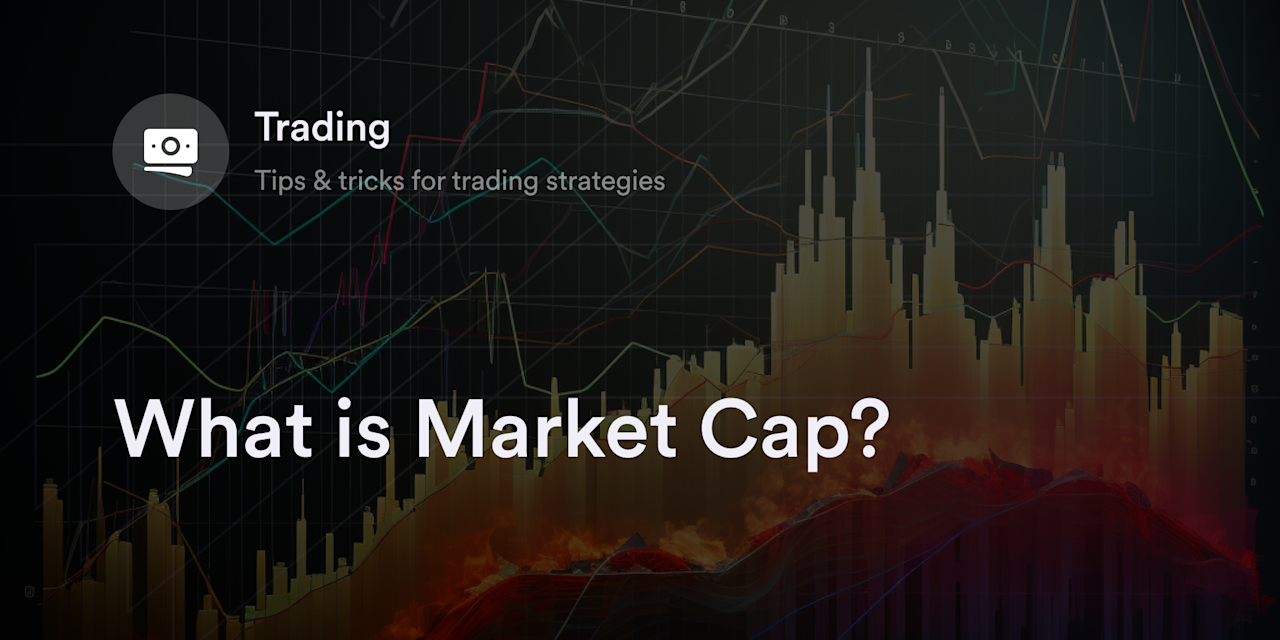


Novice cryptocurrency traders may be surprised to learn the current value of an asset doesn’t always determine the best time to buy or sell.
When traders choose to buy or sell a cryptocurrency, they must know how much each coin is worth on the open market (called the "market price"). In other words, people should understand what they’ll pay or receive when exchanging a digital asset like Bitcoin (BTC) or Ethereum (ETH).
Although market prices are critical for the daily trading activity in the cryptocurrency ecosystem, they don't provide traders with a complete picture of a cryptocurrency's worth. For more details on a project's size, influence, and risk profile, traders should turn to another metric called "market capitalization" (or “market cap”) to inform their trading strategy.
So what is market cap, and how do traders calculate this metric for their favorite digital currencies?
What is Market Cap in Crypto, and How is a Cryptocurrency’s Market Cap Calculated?
Market cap is a metric used in financial markets to determine the valuation of a trade in an asset. In the cryptocurrency industry, however, the market cap measures how much money is in a virtual coin or token.
While market cap isn't the same as market price, the two concepts are intertwined. The price per unit of each cryptocurrency is equal to its market cap divided by its circulating coin supply (the total number of coins on the open market).
For example, suppose Bitcoin (BTC) has a market cap of $500 billion USD and 19 million coins in circulation. In this case, the market price per BTC is $26,315.78 USD:
$500 billion ÷ 19 million = $26,315.78
If traders don't know a cryptocurrency's market cap, they can multiply the circulating supply by the price to figure out its market value:
$26,315.78 x 19 million = $500 billion
Remember that a cryptocurrency's "circulating supply" isn't always the same as its "total supply." The former refers to the number of coins or tokens available on cryptocurrency exchanges, while the latter figure is the maximum amount of cryptocurrency on a blockchain. For example, Bitcoin has a total supply of 21 million coins, but all of these coins won't be in circulation until 2140 due to Bitcoin's pre-set issuance algorithm. Although the current market price for a cryptocurrency uses the circulating supply, it's possible to divide the market cap by the total supply and analyze how the total value compares with the current market rate.
Why is Market Cap Important?
Market cap gives traders valuable insight into a cryptocurrency's size, stability, and growth potential—information that can't be found simply by looking at its market price.
Sometimes cryptocurrencies with an "affordable" market price already have a high market cap, which may limit their future growth prospects. For example, the cost per Dogecoin (DOGE) was $0.69 USD at its peak during the 2021 crypto bull run, which doesn't appear to be a high price in dollar terms. However, due to Dogecoin's high circulating supply and inflationary issuance schedule, it had a market cap of $89 billion at the time, a high value for digital assets. In this case, reviewing the past performance of a coin’s market cap helps traders determine a project's true value and decide whether it's overbought or attractively priced.
Using market cap also helps traders determine the risk profile of different projects. Generally speaking, the lower a cryptocurrency's market cap, the greater the chance of extreme price fluctuations and the higher the risk. By contrast, cryptocurrencies with a large market cap, like Bitcoin, tend to be less volatile than coins or tokens with a smaller market cap.
Cryptocurrency traders also watch market cap trends to gauge sentiment in the Web3 ecosystem. Suppose the market cap of small and speculative altcoins is rising faster than established projects like Bitcoin and Ethereum. In that case, market conditions are likely bullish because more traders are emboldened to take on riskier positions. By contrast, when the market cap for BTC and low-volatility stablecoins increases, it usually signals a retreat to defensive digital assets as traders fear an economic downturn. The Bitcoin Dominance chart highlights BTC's percentage of the total crypto market cap, which helps to highlight these shifting market conditions.
Three Market Cap Categories for Cryptocurrencies
To compare cryptocurrencies in terms of their market caps, analysts arrange projects into one of three categories. Understanding where a cryptocurrency falls within these labels helps people determine the expected risk and price volatility when entering a trade.
Large-cap cryptocurrencies: A large-cap cryptocurrency is typically an established digital asset with a robust developer community and a strong influence in the industry. Every trader has a different definition for what constitutes “large” or “mega-cap” status, but it's common for these digital assets to have market caps of above $10 billion. Since large-cap cryptocurrencies have the highest market caps, they tend to offer higher price stability relative to small projects because it takes more money to move the market price of large coins. Examples of large-cap cryptocurrencies include Bitcoin and Ethereum.
Mid-cap cryptocurrencies: Mid-cap cryptocurrencies aren't quite as big as large-caps, but they aren't as speculative as small-caps. Typically, these "mid-range" projects have market caps between $1 billion and $10 billion, giving them a slightly higher average price volatility and risk profile than large-cap coins. Traders with a moderate risk tolerance interested in higher growth potential tend to gravitate toward mid-cap projects.
Small-cap cryptocurrencies: Also called "low market cap crypto" or "micro-caps," small-cap assets are the most speculative cryptocurrencies with market caps below $1 billion. Often, these cryptocurrencies are experimental ventures and start-ups with high growth potential but also extreme risk. People who trade in small-cap cryptocurrencies should prepare for steep price fluctuations.
Where Do People Find a Cryptocurrency's Market Cap?
Cryptocurrency price aggregator websites like CoinMarketCap and CoinGecko offer real-time data on the market caps for thousands of cryptocurrencies. These sites automatically arrange their cryptocurrency lists on their homepages in terms of market cap, beginning with the largest coin and moving down to the tiniest projects. Visitors on CoinMarketCap and CoinGecko also have access to the global crypto market cap chart and the Bitcoin dominance score.
What is Realized Market Cap?
Realized market cap is a unique metric used to determine the average value traders pay per coin on a blockchain network.
Instead of multiplying a cryptocurrency's circulating supply by its market price, analysts interested in realized market cap focus on the average cost of each cryptocurrency when it was last transferred on the blockchain. Since the payment ledgers for cryptocurrencies like Bitcoin are public knowledge, on-chain analytics firms—such as Glassnode—use advanced software and algorithms to track the average value changes of cryptocurrencies held in crypto wallets to estimate whether most traders are in profit or loss. And since realized market cap doesn't record coins that haven't moved in years, it helps traders factor out cryptocurrency no longer in circulation due to accidental burnings or wallet lockouts.
Suppose the realized market cap for a cryptocurrency dips below the actual market cap. In this case, the relationship between these two metrics indicates most traders bought their digital assets at a premium relative to the current market price. Conversely, when the market cap rises above the realized cap, there's a good chance most traders are in profit. Traders use the realized cap as a tool to determine the general sentiment of most crypto traders and whether they feel comfortable entering the market.
Learn Cryptocurrency Fundamentals on dYdX Academy
dYdX believes in providing eligible crypto traders with high-quality education so they feel confident making trading decisions. We also offer eligible traders dozens of tools like slippage tolerance controls and sell stop-loss orders to give traders the most flexibility when entering and exiting crypto perpetual contracts. Check out our blog to learn more about how trading works on dYdX and our Academy to learn more about the cryptocurrency ecosystem at large.
Disclaimer
The content of this article (the “Article”) is provided for general informational purposes only. Reference to any specific strategy, technique, product, service, or entity does not constitute an endorsement or recommendation by dYdX Trading Inc., or any affiliate, agent, or representative thereof (“dYdX”). Use of strategies, techniques, products or services referenced in this Article may involve material risks, including the risk of financial losses arising from the volatility, operational loss, or nonconsensual liquidation of digital assets. The content of this Article does not constitute, and should not be considered, construed, or relied upon as, financial advice, legal advice, tax advice, investment advice, or advice of any other nature; and the content of this Article is not an offer, solicitation or call to action to make any investment, or purchase any crypto asset, of any kind. dYdX makes no representation, assurance or guarantee as to the accuracy, completeness, timeliness, suitability, or validity of any information in this Article or any third-party website that may be linked to it. You are solely responsible for conducting independent research, performing due diligence, and/or seeking advice from a professional advisor prior to taking any financial, tax, legal, or investment action.
You may only use the dYdX Services in compliance with the dYdX Terms of Use available here, including the geographic restrictions therein.
Any applicable sponsorship in connection with this Article will be disclosed, and any reference to a sponsor in this Article is for disclosure purposes, or informational in nature, and in any event is not a call to action to make an investment, acquire a service or product, or purchase crypto assets. This Article does not offer the purchase or sale of any financial instruments or related services.
By accessing this Article and taking any action in connection with the information contained in this Article, you agree that dYdX is not responsible, directly or indirectly, for any errors, omissions, or delays related to this Article, or any damage, injury, or loss incurred in connection with use of or reliance on the content of this Article, including any specific strategy, technique, product, service, or entity that may be referenced in the Article.







